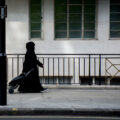Is the headscarf an Islamic requirement?
Between the headscarf and Islam:
Is the headscarf an Islamic requirement?
The headscarf – we surely have heard about it. But whether or not to wear, why to wear, and what to wear is not as clear as common understandings might imply.
The headscarf is not an Islamic invention
The veil has been part of women’s clothing in many regions of the Arabian Peninsula before the Quran was revealed in the 7th century.[1] At the time of revelation, it was customary that people left their houses to defecate, even at night. Women had to deal with the risk of being harassed by strange men who often claimed that they had mistaken them with female slaves. Veiling has thus been used to distinguish them from female slaves since slaves were not allowed to wear coverings.[2] Besides, it was considered as a symbol of women’s modesty and respectability to hide the hair and sometimes the whole body from the male gaze.[3]
What is worth mentioning here, is that the headscarf has also been part of female clothing in Europe since ancient times. In the Middle Ages, head coverings became customary among Jewish and Christian women: young unmarried women wore their hair down, while married women covered their hair with scarves or hairnets.[4] It was considered a sign of decency for women to hide their heads and sometimes the whole body from the gaze of men. Based on the biblical passages in 1 Corinthians[5] from the New Testament, the Canon Law stipulated until the beginning of 1983 that women must wear a head covering at Mass.[6]
What does the Quran say about the headscarf?
The normative basis for veiling can be found both in the Quran, the Muslim holy book, and the hadiths, statements attributed to the Prophet Muhammad.[7] The Quran contains no literal reference to a requirement to veil. Nevertheless, according to the holy book, women should not display their beauty and charms outside of the house and in the presence of strange men.[8] Besides, they should veil themselves in coverings[9] to protect themselves from being harassed. These passages can trace back to a written incident, according to which Muhammad’s wives were harassed when they left the house at night to go to the restroom.[10] It should be noted as well that the Quran is addressed to both women and men to dress appropriately.[11] According to one of the often-cited Quranic passages concerning veiling, men are also required to lower their gaze and behave themselves.[12]
An inner-Islamic debate: to wear the headscarf or not?
Scholars disagree about whether these statements apply only to the prophet’s wives or to all Muslim women, and whether they refer to concrete historical circumstances or have a universal character.[13] Some Islamic theologians argue that the respective passages were thought out of the concrete historical situation in the 7th century and thus should be understood historically and critically. Besides, it can not be clearly read out of the Quran whether the headscarf is an Islamic duty.[14] Therefore, faithful need to decide for themselves. One of the tasks within Islam is then to create more space for women to reflect and make their own decision regarding whether or not to wear the headscarf.[15]
The headscarf is not exactly ‘the headscarf’: what exactly to wear?
The Quran leaves a lot of space for interpretation. Correspondingly, the aforementioned verses are not very precise concerning the exact appearance and condition of the covering. Depending on countries or regions, personal style, and individual religiousness, there are various types of covering, such as the hijab (head covering that covers the hair, neck and chest, but not the face),[16] the niqab (face veil that leaves the eyes uncovered), and burka (full-body covering which covers the eyes with a mesh screen).[17] Besides, there are also traditional coverings that can not be justified based on the Quran, such as face masks which are sometimes used even in the absence of strange men.[18] Even in countries where women are required to cover, the respective (legal) rules do not give much information on the precise features of veiling. For example, in Iran, women are required to wear ‘a proper hijab’ in public and a chador (dark cloak that covers the head and body, but not the face) in religious places.[19] And for decades, women in Saudi Arabia were required to be covered with a black veil. However, in March 2018, the young Crown Prince Mohammad bin Salman declared that “[t]he decision is entirely left for women to decide what type of decent and respectful attire she chooses to wear.”[20]
To whom does the sovereignty of interpretation belong?
As can be seen, numerous questions remain open. Nevertheless, one thing is certain: there is a wide range of understandings of veiling and types of coverings which have changed and developed throughout history. In other words, one should ask oneself to whom the sovereignty of interpretation belongs, before certain symbolic meanings are attributed to the headscarf.
Interested in similar topics? Create a free account on our Dashboard and receive weekly updates.
[1] Susanne Enderwitz: Der Schleier im Islam. In: Feministische Studien. Heft 2, 1983, S. 96.
[2] Why do Muslim women wear a hijab?; Zur Kulturgeschichte des Kopftuches Ausarbeitung
[3] Zur Kulturgeschichte des Kopftuches Ausarbeitung
[4] Zur Kulturgeschichte des Kopftuches Ausarbeitung; Muslimische Frauen und das Kopftuch–Hijab und Islamischer Feminismus; Why do Muslim women wear a hijab?
[5] 1 Corinthians 11 NIV – On Covering the Head in Worship
[6] Zur Kulturgeschichte des Kopftuches Ausarbeitung,
[7] Muslimische Frauen und das Kopftuch–Hijab und Islamischer Feminismus
[8] Surah 24:31: Verse (24:31) – English Translation
[9] Surah 33:59: Verse (33:59) – English Translation
[10] Zur Kulturgeschichte des Kopftuches Ausarbeitung; Muslimische Frauen und das Kopftuch–Hijab und Islamischer Feminismus
[11] Muslimische Frauen und das Kopftuch–Hijab und Islamischer Feminismus
[12] Surah 24:30: Verse (24:30) – English Translation
[13] Zur Kulturgeschichte des Kopftuches Ausarbeitung; Why do Muslim women wear a hijab?
[14] Das Kopftuch – ein Symbol der Unterdrückung der Frau?
[15] Die Stellung der Frau im Islam: Nur gehorsame Ehefrau und gute Mutter?; Das Kopftuch – Symbol der Würde oder Unterdrückung?
[16] Whereas the term “headscarf” is mostly used by the non-Muslims in the debate on the covering of Muslim women, Muslim women in Germany themselves usually speak of covering or hijab.
[17] Muslimische Frauen und das Kopftuch–Hijab und Islamischer Feminismus; Dies ist keine Burka
[18] Muslimische Frauen und das Kopftuch–Hijab und Islamischer Feminismus
[19] Islamic Penal Code of Iran;
[20] Saudi women should be able to choose whether to wear head cover or black abaya in public, says Crown Prince | The Independent; Frauen feiern die neue Freiheit






